Fairy tales and folklore are abundant in stories about beasts and are wide spread in cultures all over the world, depicting the past and sometimes the present by the use of monsters that, thus, have entered history through the secret door of folk tales….
Such narrative often shares a story that teaches a moral lesson or emphasize the importance of kindness and bravery no matter what. They mostly make use of a mean character, a monster that instills fear. It is through this fear that the message is remembered. Because fear shapes the mind and gives the memory a kick and, sometimes, a beast does not need a hero to be just that, freak.
This is, by no means, a comprehensive list, but one to inspire future reading, writing, and further work as I do intent to update it regularly.
Greek Monsters
Cerberus, the Hound of Hades in Greek mythology
Is being the son of monsters making one a beast? Cerberus, hound of Hades, certainly looked like one with his 3 heads (or 50, or 100), a serpent tail and extra snakes protruding from his body. Often a symbol for an impossible task (Heracles) and gluttony (Dante).
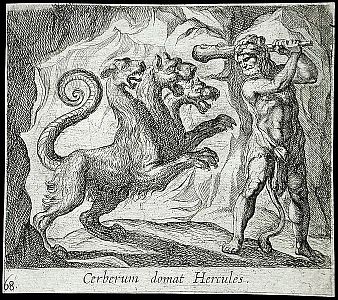
Medusa, the only mortal of the Gorgon sisters from Greek legends
Medusa is described as a winged human female. She has living venomous snakes in place of hair. Those who gazed into her eye’s will certainly turn to stone, an ability her head retained even after her death and decapitation. Interesting is that it appears there are no records of Medusa turning women to stone. Of course, related to this observation there is a fascinating Freudian interpretation.

The Minotaur
Anyone who read ‘The Legends of Olympus’ in childhood, will probably remember that the Minotaur was a fantastic creature, half human, half bull. Because the Minotaur liked to devour people he is locked in a labyrinth built by Daedalus from which the creature could not escape. In order to prevent him from trying to find his way out, King Minos sacrificed seven men and seven women a year to quench the hunger of the monster. Eventually the Minotaur is killed by Theseus who manages to get out of the maze with the help of the invisible thread of the Ariadne (which was in love with him). Alas, Theseus shows no gratitude towards her. One would say his negligence was punished by Gods as Theseus fails to put up the white sail on his return home (something he promised his father to do if he was victorious). Seeing the black sail his father, in desperation, kills himself by drowning in the sea that now carries his name.
The Mermaid and the Siren
In Greek mythology Sirens were believed to combine women and birds in various ways. In early Greek art, Sirens were represented as birds with large women’s heads, bird feathers and scaly feet, ‘Winged maidens, daughters of the Earth.’ Later, sirens are depicted as female figures with legs of birds, with or without wings, often playing a musical instrument especially the harp. Perhaps where the arm movement of a harpist looks like the flapping of a bird’s wings.
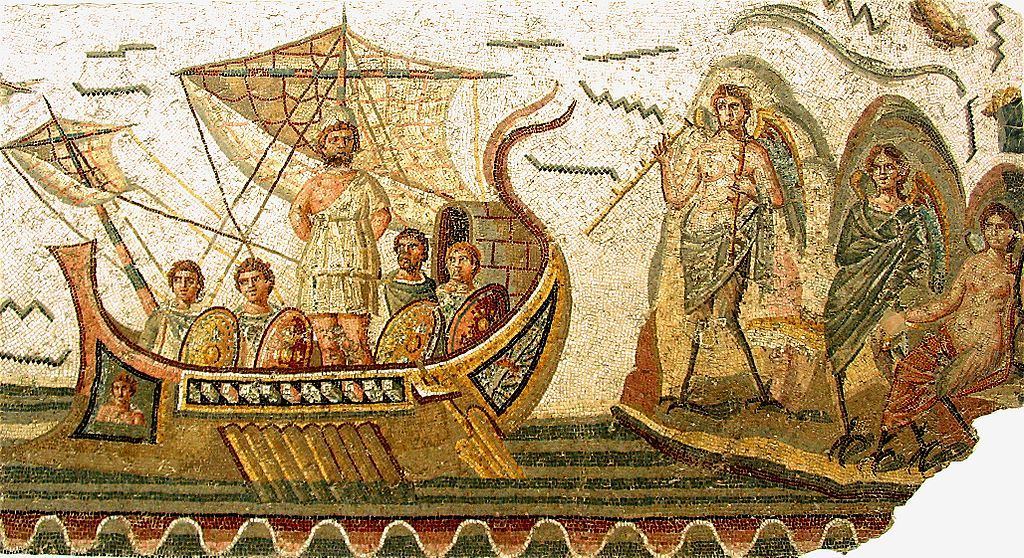
According to Ovid’s Metamorphoses, the Sirens were the companions of young Persephone and were given wings by Demeter to search for Persephone when she was abducted. Their song is continually calling for her.
According to Latin author Hyginus, sirens were fated to live only until the mortals who heard their songs were able to pass them by.
The term “siren song” refers to an appeal that is hard to resist but that, if heeded, will lead to a bad result.
By the Middle Ages, the figure of the siren has shifted to the more enduring mermaid.
Part female and part fish, literature shows us that not all mermaids are as gentle as Ariel. In Odyssey, Homer frighteningly illustrates how sirens drown those who listen to their song. Greek legends speak of mermaids who love consuming human flesh, being surrounded by decomposed corpses. Far from being a romantic character, a siren would lure you in the depths of her aquatic world, functioning as a character of horror for anyone who fails to follow their charming song.
North European Monsters
Fenris or Hróðvitnir from Norse Mythology
Fenris or Fenriror Hróðvitnir is a monster with a wolf’s appearance encountered in Norse mythology. He is one of the sosn of Loki and of giant Angrboda. Fenris is encaged because of a prophecy announcing that a wolf and his family will one day destroy the world. Eventually, Fenris will fulfill the prophecy by killing Odin, the emperor of the gods, during the Viking Armageddon, Ragnarok. Fenrir appears in the Poetic Edda, a 13th century compilation of Norse poems based on earlier traditional sources.
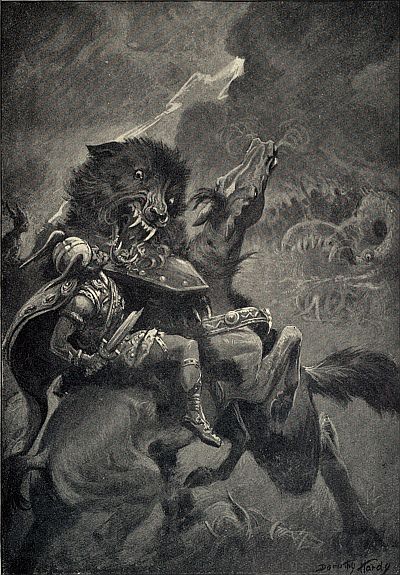
Kraken or Hafgufa (sea mist)
A mythical cephalopod-monster of Scandinavian sea-tales (“krake” means twisted in Swedish), Kraken it traditionally figured as malign, and better re-imagined embodying the mystery of the ocean.

Hafgufa (Icelandic, haf “sea” + gufa “steam”) is the massive sea monster depicted in the Örvar-Odds saga. It lived in the Greenland Sea and was said to disguise itself as an island or pair of rocks rising from the sea.
“Below the thunders of the upper deep;
Far far beneath in the abysmal sea,
His ancient, dreamless, uninvaded sleep
The Kraken sleepeth (…)
There hath he lain for ages, and will lie
Battening upon huge seaworms in his sleep,
Until the latter fire shall heat the deep;
Then once by man and angels to be seen,
In roaring he shall rise and on the surface die.”
(The Kraken by Alfred Tennyson, 1830)
English Monsters
Grendel from Boewulf
One of the monsters described in the epic poem Boewulf, Grendel is a descendant of Cain, perhaps humankind’s first killer. Like all of Cain’s descendants Grendel is cursed to have a hideous appearance due to his physical deformities. Never described in detail, Grendel is presented as ‘a creature of darkness, exiled from happiness and accursed of God, the destroyer and devourer of our human kind.’
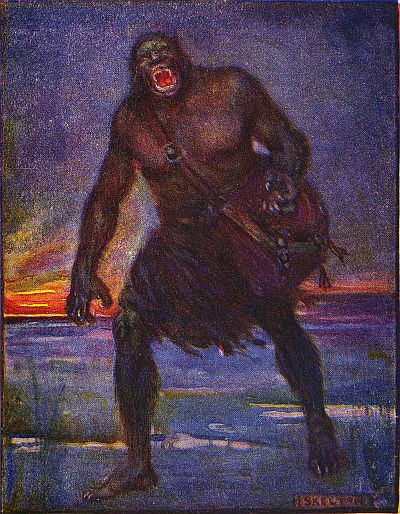
The Dragon
Dragons have an extensive history, being widespread throughout folktales and legends since ancient times. They are depicted as flying monsters, often so big that they could easily be compared with elephants.
Tolkien’s Smaug Dragon (from The Hobbit) is ruthless and greedy, a trait expected to be found in such a beast. As a visual representation of his evil spirit Smaug spits fire to make sure that the mountain and the treasure belong exclusively to him. He can also stir hurricanes with his wings, earthquakes with his tail, while his teeth are like swords, and his breath spits death.
Beast of Bodmin Moor
If you live in Cornwall, watch out for the Beast of Bodmin Moor, a mysterious cat blamed for mutilating local livestock. This could very well be considered as one of the ABCs (Alien, or Anomalous, Big Cats), the British big cats, phantom cats and mystery cats often reported as “panthers”, “pumas”, or “black cats”.
Other European Monsters
The Ogre from Puss in Boots
Do you remember him? The fairy tale is of Italian origin, Il gatto con gli stivali.
While representing the Marquis of Carabas, the cat happens upon a castle inhabited by an ogre who is capable of transforming himself into a number of creatures. The ogre displays his ability by changing into a lion, frightening the cat, who then tricks the ogre into changing into a mouse. The cat then pounces upon the mouse and devours it.

Monster of Ravenna
Most probably an omen regarding the outcome of the 1512 Battle of Ravenna it was fir recorded by diarist Sebastiano di Branca Tedallini on March 8. A child was born to a nun and a friar, and thus he was marked by a horned head, the letters YXV on its chest, and with one leg hairy and cloven-hoofed while the other leg’s midsection grew a human eye.
“The horn [indicates] pride; the wings, mental frivolity and inconstancy; the lack of arms, a lack of good works; the raptor’s foot, rapaciousness, usury, and every sort of avarice; the eye on the knee, a mental orientation solely toward earthly things; the double sex, sodomy. And on account of these vices, Italy is shattered by the sufferings of war, which the King of France has not accomplished by his own power, but only as the scourge of God.” (Johannes Multivallis, 1512)
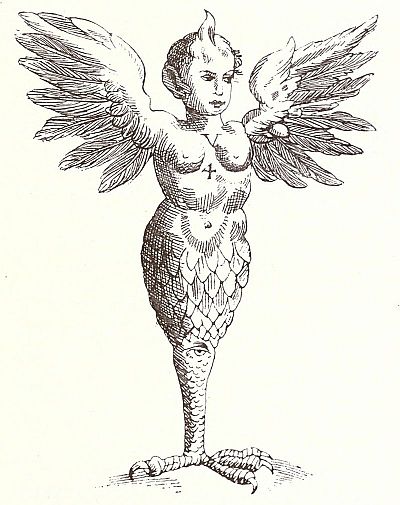
With time, the description of the Ravenna monster evolved, being tied with the image of Frau Welt and her seductive powers (a beautiful, beguiling woman when viewed the front, while her back is full of pus and hideous vermin). Thus way, the monster of Ravenna and Frau Welt become educational tools during the Middle Ages.
Note: do not confuse Frau Welt with Mutter Courage.
The Tarasque
A French monster from Provence, the Tarasque looked like a dragon with lion’s head, had an ox’s body with a turtle shell on top. He was tamed by Saint Martha in the Golden Legend.
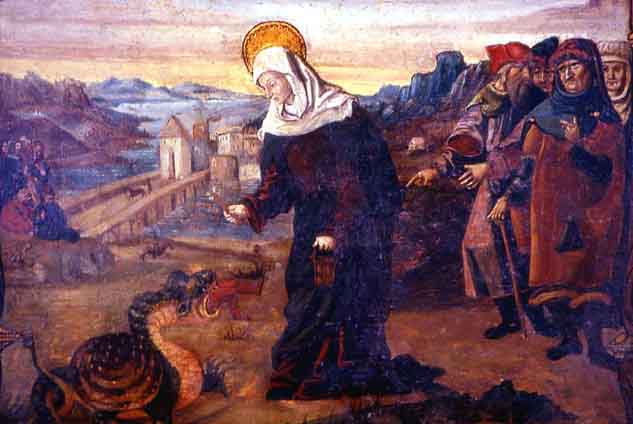
.
Monsters from Middle East and Asia
Al, the Afghan monster
With fiery eyes, horns, iron teeth, talons for fingernails & floating appearance, living in damp corners and swamps, comes the Al, a monster from the Afghanistan folklore. Attacking women and children, Al prefers the liver, but eats any corpses.
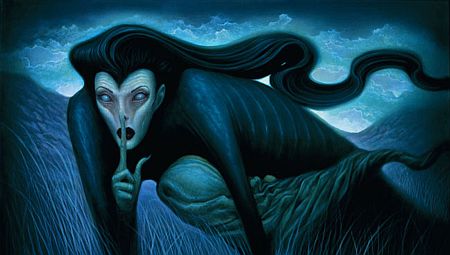
The Futakuchi-Onna
A futakuchi-onna (二口女, lit. “two-mouthed woman”) is a Japanese mythological monster depicted as having two mouths, basically a woman with a toothy mouth hidden on the backside of her head.

Hone-Onna
The skeleton woman’ is a Yōkai, a Japanese demon, often depicted as an aged female that carries a lantern decorated with botan flowers and visit the house of a man she loved back when she was still alive. Of course he sees her as the young woman she used to be, but if anyone else catches a glimpse of her they will see her at the skeleton she actually is.

The Gashadokuro
Also from Japanese Folklore comes the story of a a giant skeleton made up of the bones of people who have died from starvation. If Gashadokuro sees you, it will bite your head off and drink the blood that drains out of your decapitated body. Sweet dreams.
Oni
An Oni is a kind of, ogre, or troll in Japanese folklore. They are strong and large build, with one or more horns growing out of their heads, wearing loincloths of tiger skin, and carrying a typical iron spiked club. Their skin is usually red, blue or green.

Onis are popular characters in Japanese art, literature (the 14th century fairytale of Momotaro, Peach Boy), and theatre.
Jiangshi
The jiangshi is a Chinese hopping vampire known as phi dip chin in Thai, hantu pocong in Malay, and vampir cina in Indonesia. It is depicted as a corpse dressed in clothes from the Qing Dynasty era that moves around by hopping. It kills living creatures to absorb their qi, “life force”, usually at night, while during daytime it rests in a coffin or hides in dark places.
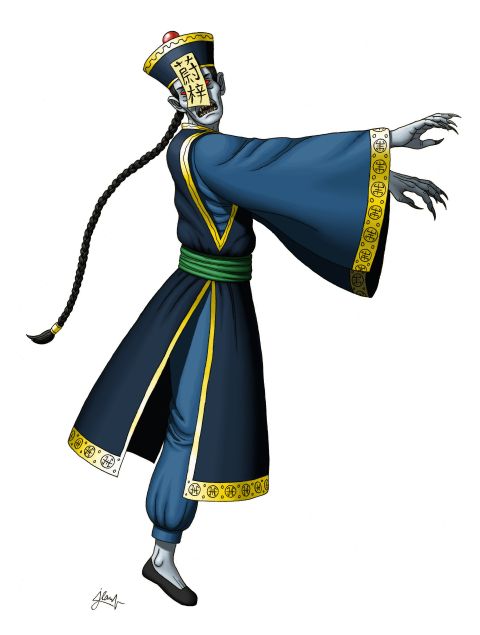
Jiangshifrom originates in the folk practice of “transporting a corpse over a thousand li“. The relatives of a person who died far away from home could not afford vehicles to bring the deceased’s body home for burial, so they would hire a Taoist priest to reanimate the dead person and teach him to “hop” home. The transport happened only at night and would ring bells to notify others in the vicinity of their presence because it was considered bad luck for a living person to set eyes upon a jiangshi.
American Monsters
The Hidebehind
Have you ever felt watched while out in the forest? It is the hidebehind. This a nocturnal creature from American folklore that preys upon the humans who wander the woods. He is blamed for the disappearances of any loggers who failed to return to camp. It is believed he has the ability to conceal itself, mostly often behind trees, ‘hidebehind‘.

Jersey Devil
This is a kangaroo-like / dragon-like creature with a goat or horse-like head, leathery bat-like wings, horns, small arms with clawed hands, legs with cloven hooves, and a forked tail. It has been reported to move quickly and is often described as emitting a high-pitched “blood-curdling scream”
According to folklore, the Jersey Devil originates Mother Leeds in 1735. The legend says that Mother Leeds had 12 children and when she fell pregnant with her 13th she cursed the baby. It was a stormy night when the baby was born, a normal child who soon changed his appearance developing hooves, a goat’s head, bat wings, and a forked tail. He flew up the chimney and head for the pine forest.
Yes, there is a NHL hockey team named after this creature – perhaps due to their speed?
Modern Monsters
Jabberwocky from Through the Looking-Glass, and What Alice Found There
Lewis Carroll’s character is all the more formidable as he goes beyond everything I knew about monsters. It is a new appearance, presented by the author through a playful and absurd poem. The lack of information about the bizarre creature, along with the uncertain and fantastic description increases the fear of the unseen character. Our fear grows as we decipher the language. We learn that Jabberwocky is like a beast galloping towards its prey. He salivates at the thought of snatching someone’s flesh from the bones, devouring with his jaws anyone who gets in his way. The fact that his eyes are on fire makes him terribly frightening, even if only seen in the dark.

The Nothing from The Neverending Story
In order for a monster to be scary, it does not have to look like a beast. The more mysterious it is, the more it overcomes our fears.
The Nothing… By the mere fact that there is nothing in its presence, that is to say, of the unknown, its force is both evil and darkness and it seems unable to be defeated or controlled. The Nothing is all that humanity would never have imagined, namely the supreme evil and the most destructive power shed to mortals. Some even let themselves fall inside willingly because they get too close to the Nothing. The Nothing that exerts an irresistible power of attraction and thus it grows.
The Nothing, what is it? where it comes from? How it became to be just that, Nothing?

The Clown
Pennywise, Stephen King’s character in IT, is one of the creepiest literary monsters by far. Speaking of coulrophobia. But just as a (giant) spider, Pennywise is the nightmare in itself.
Cryptozoology and its Monsters
Cryptozoology is a pseudoscience and subculture that aims to prove the existence of entities from the folklore record, such as Bigfoot, the Chupacabra, the Loch Ness monster, the Yeti or Mokele-mbembe. Cryptozoologists refer to these entities as cryptids, a term coined by the subculture.
Perhaps our interest and fascination with monsters does not lie in the love of the macabre, but in an evolutionary need to learn about them, their stories, habits, diet and all, in order to recognize them, fight them, and annihilate them as well as what they symbolize.
You can read about Romanian Monsters of Myth and Folklore too. Or you might enjoy reading about:
4 Romanian Myths between Culture, History and the Sacred
My Top Heroes from Romanian Folktales


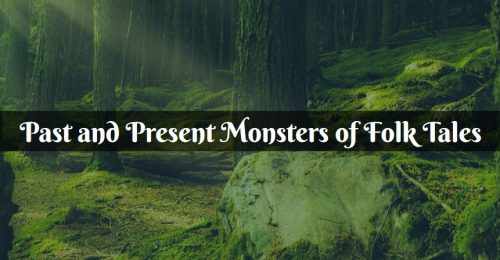
An interesting read! The monster from Ravenna was new to me and I really am not sure what to make of it? It inspires more pity than fear, I think.
Very much so. Proving how people feared what they couldn’t understand and hated what they couldn’t vanquish.
It’s interesting how every culture has monsters, there are many here that I have never heard of, Pat. A, I wrong if I say that almost every culture speaks of dragons? Is it possible that they may have found dinosaur fossils and assumed they were dragons? I also was unaware that Medusa had wings. Fascinating post!
That’s a great point you raised, Mark, your connection between dino bones and dragons. It makes perfect sense 😉
Fabulous article, Patricia – and several of these nasties are new to me – including the Jersey devil! Very good images as well. Toni x
I feel more in the know for having read your post! Thank you, Pat. I’m currently reading Murakami’s Kafka on the Shore, and he references all sorts of Japanese literature that hasn’t made it over to my Western eyes.
Oh, Crystal. Thank you 🙂 Glad to hear it.
I love Murakami, haven;t read this one though.
Japan is fascinating in every way, isn’t it 🙂
This is my first Murakami. It is wild and surreal. I would love to visit Japan one day—yes, a fascinating culture.
Ooh, me too 🙂